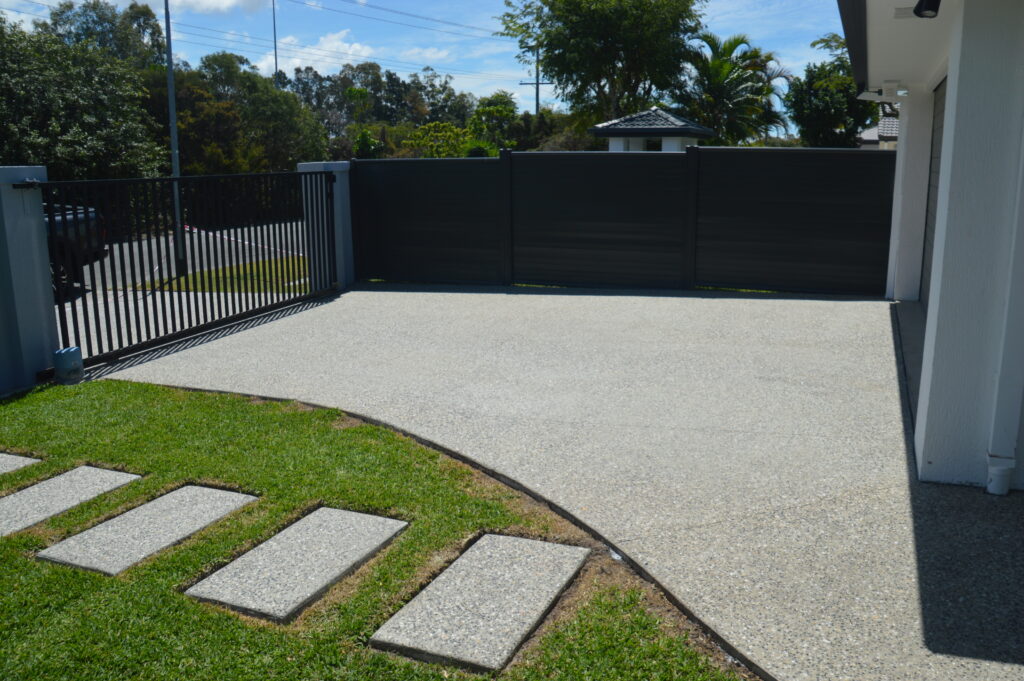Dreaming of a stunning new concrete driveway, a resort-style patio, or a poolside escape in Queensland? Before the concrete starts flowing, it’s crucial to understand when building permits are required. Navigating the approval process can be confusing, but this guide breaks it down – empowering you to start your Queensland concrete project on the right foot.
When Do You Need a Building Permit for Concrete Work in Queensland?
Here’s a general overview, but always double-check with your local council, as regulations can vary slightly:
- Structural Projects: Anything affecting the load-bearing capacity of your property typically needs a permit. This includes house slabs, footings, retaining walls over a certain height, and some freestanding structures.
- Driveways: New driveways or significant changes to existing ones often require permits. Factors like width, slope, and connection to public roads can trigger the need for approval. Simple Like-for-Like Replacement: If you’re keeping the exact dimensions, slope, materials, and the crossover isn’t changing, you may be exempt.
- Patios & Other Large Areas: Extensive patio slabs, especially those attached to the house or involving significant excavation, may require approval.
- Concrete Retaining Walls: Height Matters, Queensland generally requires building permits for retaining walls exceeding 1 meter in height (measured from the natural ground level). Below that, there might be council rules, but not a full-blown permit. Structural Stability. Even if under 1 meter, if the retaining wall supports a load (like a driveway or building) or poses a risk if it fails, it likely requires a permit and engineering.
Important Note: Even if a building permit isn’t needed, plumbing or electrical work involved in your project might require separate permits and licensed tradespeople.
The Building Approval Process in Queensland
- Pre-Planning Consultation: Contact your local council to discuss your project and find out specific requirements for your area.
- Engaging Professionals: Depending on the project, you may need an engineer (for structural work), a surveyor, or other specialists to provide plans and documentation.
- Choosing a Certifier: You’ll submit your application through either the council or a private building certifier. Certifiers can often streamline the process.
- Application & Documentation: Submit detailed plans, specifications, and relevant reports as outlined by your council or certifier.
- Assessment & Decision: The council or certifier reviews your application to ensure compliance with building codes, zoning regulations, and local plans.
- Inspections: Depending on the project, mandatory inspections might be required at various stages of construction.
Common Council Considerations for Concrete Projects
- Drainage & Stormwater Runoff: Queensland councils are focused on preventing flooding. Your plans must show how your concrete project manages water flow and won’t negatively impact neighbors.
- Soil Conditions: Reactive soils (prone to expanding/contracting) are common in parts of Queensland. Soil reports and appropriate engineering may be needed.
- Boundary Setbacks: Ensure your concrete structure adheres to setback distances from property lines as dictated by your local zoning.
- Neighborhood Character: In some areas, design guidelines might influence your concrete project’s appearance and finishes.
DIY vs. Hiring a Pro
- Small Projects: If your project is simple and clearly falls under the exempt category, tackling it yourself might be feasible.
- Complex Work: For anything requiring structural engineering, council negotiations, or ensuring code compliance, a reputable concrete contractor is often your best bet.
- The Benefit of Pros: Experienced contractors know the permit process inside and out and can often secure approvals more smoothly.
Avoiding Permit Headaches – Top Tips
- Do Your Homework: Research thoroughly online with resources like the Queensland Building and Construction Commission (QBCC) and your local council website.
- Consult Early: Reach out to your council before getting too far into designing your dream project, as restrictions can derail plans.
- Complete Documentation: Missing information is a major cause of delays. Work with your professionals to ensure your submission is thorough.
- Factor in Timing: The approval process can take weeks or even months, so build this into your project timeline.
Queensland Resources at Your Fingertips
- Queensland Building and Construction Commission (QBCC): https://www.qbcc.qld.gov.au/
- Your Local Council Website: https://www.goldcoast.qld.gov.au/Home
- Master Builders Queensland: https://www.mbqld.com.au/
Disclaimer: Building regulations are complex. This guide is for informational purposes only and doesn’t substitute professional advice or consulting your local council.

